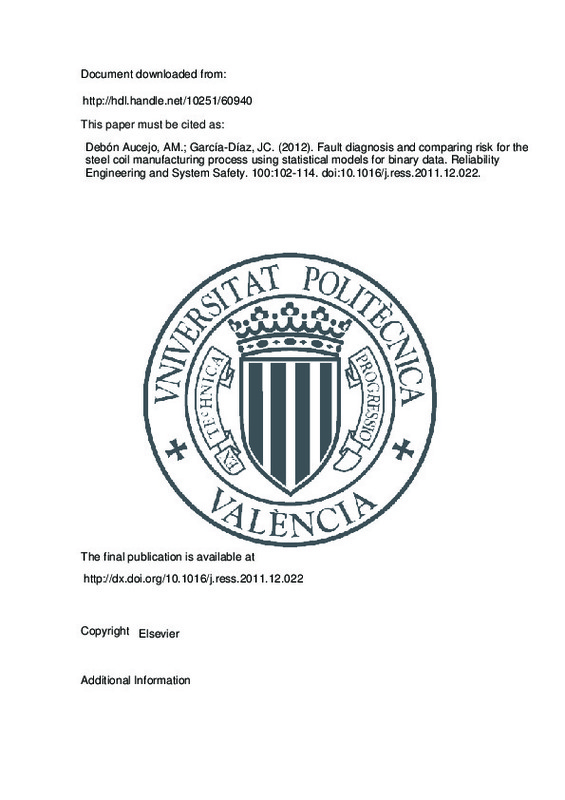JavaScript is disabled for your browser. Some features of this site may not work without it.
Buscar en RiuNet
Listar
Mi cuenta
Estadísticas
Ayuda RiuNet
Admin. UPV
Fault diagnosis and comparing risk for the steel coil manufacturing process using statistical models for binary data
Mostrar el registro sencillo del ítem
Ficheros en el ítem
| dc.contributor.author | Debón Aucejo, Ana María
|
es_ES |
| dc.contributor.author | García-Díaz, J. Carlos
|
es_ES |
| dc.date.accessioned | 2016-02-16T15:40:26Z | |
| dc.date.available | 2016-02-16T15:40:26Z | |
| dc.date.issued | 2012-04 | |
| dc.identifier.issn | 0951-8320 | |
| dc.identifier.uri | http://hdl.handle.net/10251/60940 | |
| dc.description.abstract | [EN] Advanced statistical models can help industry to design more economical and rational investment plans. Fault detection and diagnosis is an important problem in continuous hot dip galvanizing. Increasingly stringent quality requirements in the automotive industry also require ongoing efforts in process control to make processes more robust. Robust methods for estimating the quality of galvanized steel coils are an important tool for the comprehensive monitoring of the performance of the manufacturing process. This study applies different statistical regression models: generalized linear models, generalized additive models and classification trees to estimate the quality of galvanized steel coils on the basis of short time histories. The data, consisting of 48 galvanized steel coils, was divided into sets of conforming and nonconforming coils. Five variables were selected for monitoring the process: steel strip velocity and four bath temperatures. The present paper reports a comparative evaluation of statistical models for binary data using Receiver Operating Characteristic (ROC) curves. A ROC curve is a graph or a technique for visualizing, organizing and selecting classifiers based on their performance. The purpose of this paper is to examine their use in research to obtain the best model to predict defective steel coil probability. In relation to the work of other authors who only propose goodness of fit statistics, we should highlight one distinctive feature of the methodology presented here, which is the possibility of comparing the different models with ROC graphs which are based on model classification performance. Finally, the results are validated by bootstrap procedures. | es_ES |
| dc.description.sponsorship | The authors are indebted to the anonymous referees whose suggestions improved the original manuscript. This work was supported by a grant from PAID-06-08 (Programa de Apoyo a la Investigacion y Desarrollo) of the Universitat Politecnica de Valencia. | |
| dc.language | Inglés | es_ES |
| dc.publisher | Elsevier | es_ES |
| dc.relation.ispartof | Reliability Engineering and System Safety | es_ES |
| dc.rights | Reserva de todos los derechos | es_ES |
| dc.subject | Generalized additive models | es_ES |
| dc.subject | ROC curve | es_ES |
| dc.subject | Bootstrapping | es_ES |
| dc.subject | Generalized linear models | es_ES |
| dc.subject.classification | ESTADISTICA E INVESTIGACION OPERATIVA | es_ES |
| dc.title | Fault diagnosis and comparing risk for the steel coil manufacturing process using statistical models for binary data | es_ES |
| dc.type | Artículo | es_ES |
| dc.identifier.doi | 10.1016/j.ress.2011.12.022 | |
| dc.relation.projectID | info:eu-repo/grantAgreement/UPV//PAID-06-08/ | es_ES |
| dc.rights.accessRights | Abierto | es_ES |
| dc.contributor.affiliation | Universitat Politècnica de València. Departamento de Estadística e Investigación Operativa Aplicadas y Calidad - Departament d'Estadística i Investigació Operativa Aplicades i Qualitat | es_ES |
| dc.description.bibliographicCitation | Debón Aucejo, AM.; García-Díaz, JC. (2012). Fault diagnosis and comparing risk for the steel coil manufacturing process using statistical models for binary data. Reliability Engineering and System Safety. 100:102-114. https://doi.org/10.1016/j.ress.2011.12.022 | es_ES |
| dc.description.accrualMethod | S | es_ES |
| dc.relation.publisherversion | http://dx.doi.org/10.1016/j.ress.2011.12.022 | es_ES |
| dc.description.upvformatpinicio | 102 | es_ES |
| dc.description.upvformatpfin | 114 | es_ES |
| dc.type.version | info:eu-repo/semantics/publishedVersion | es_ES |
| dc.description.volume | 100 | es_ES |
| dc.relation.senia | 233632 | es_ES |
| dc.contributor.funder | Universitat Politècnica de València |







![[Cerrado]](/themes/UPV/images/candado.png)

